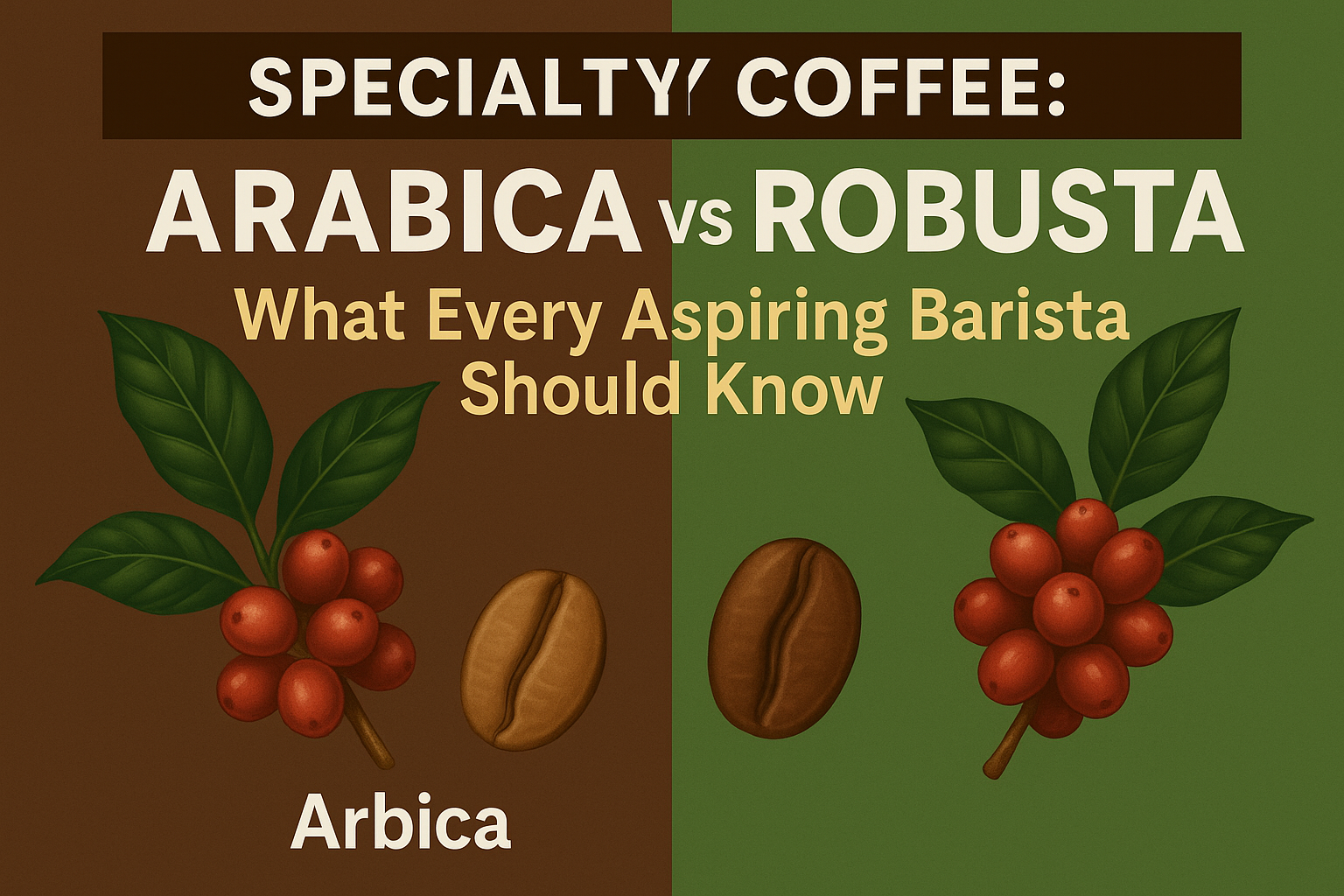Understanding the difference between Arabica and Robusta coffee beans is fundamental for anyone who wants to become a barista.
These two species dominate global coffee production and directly impact flavor, quality, and customer experience.
If you plan to work in a specialty coffee shop or simply want to brew better coffee at home, knowing how Arabica and Robusta differ will give you an edge in technique, communication, and confidence.
What Are Arabica and Robusta?
Arabica (Coffea arabica) and Robusta (Coffea canephora) are the two most widely cultivated coffee species in the world. Together, they account for over 95% of global coffee production.
Arabica is known for its smoother, sweeter flavor and is considered the higher-quality bean. Robusta, on the other hand, is stronger, more bitter, and has nearly double the caffeine content.
As a barista, understanding how these beans affect flavor, texture, and brewing technique is a core part of your training.
Flavor Differences Between Arabica and Robusta
Arabica is prized in the specialty coffee world for its complex and delicate flavor profile. It often has notes of fruit, floral tones, chocolate, or nuts. These flavors are enhanced when roasted lightly to preserve their natural characteristics.
Robusta tends to have a heavier body and bolder, earthier flavors. It can taste woody, nutty, or even slightly rubbery. Its high caffeine content also contributes to its bitterness.
For customers who enjoy strong, full-bodied coffee, Robusta can deliver a satisfying experience. But for those seeking balance and subtlety, Arabica is the clear winner.
Caffeine Content: Why It Matters
One of the most notable differences is caffeine content. Robusta contains 2.2–2.7% caffeine, while Arabica typically contains 1.2–1.5%.
Higher caffeine levels not only affect the strength of the beverage but also its bitterness. Caffeine is naturally bitter, which explains why Robusta often tastes harsher.
Caffeine also acts as a natural pesticide. That’s why Robusta plants are more resistant to pests and diseases, making them easier and cheaper to grow in large quantities.
Arabica plants, in contrast, are more delicate. They require specific altitudes, cooler temperatures, and careful cultivation to thrive.
Growing Conditions and Origins
Arabica grows best at higher altitudes between 600 and 2,000 meters above sea level. It prefers cooler climates and volcanic soil, which can add complexity to its flavor.
Robusta thrives in lower altitudes, warmer temperatures, and humid environments. It’s widely grown in countries like Vietnam, Uganda, and parts of Brazil and India.
Because Arabica is harder to cultivate and more sensitive to climate changes, it’s generally more expensive to produce. That’s part of what makes it the preferred choice in specialty cafés.
Visual and Structural Differences
Even the beans themselves look different. Arabica beans are oval with a curved crease, while Robusta beans are rounder with a straight crease.
If you learn to identify beans by shape and size, it will become easier to recognize blends and evaluate bean quality before brewing.
In your work as a barista, this small detail can help you confidently explain origin and bean type to curious customers.
Arabica in Specialty Coffee
Arabica is considered the standard for specialty coffee. The Specialty Coffee Association (SCA) uses Arabica exclusively in its grading and cupping protocols.
Single-origin coffees, microlots, and high-end roasters almost always use 100% Arabica beans. These coffees are often roasted lightly to highlight the bean’s origin and flavor profile.
In competitions and high-end cafés, Arabica is the default. If you want to work in that environment, you’ll need to develop a sharp understanding of its properties.
Does Robusta Belong in Specialty Coffee?
While Robusta is often associated with instant coffee or low-quality blends, that’s beginning to change.
A movement called Fine Robusta has emerged, focusing on high-quality Robusta beans grown with care. These beans are hand-picked, washed, and processed similarly to specialty Arabicas.
When used correctly, Robusta can add body, texture, and crema — especially in espresso. Some baristas use 10–30% Robusta in their espresso blends to create a more intense and creamy shot.
Robusta also works well in cold brew and coffee-based cocktails where boldness is a plus.
Brewing with Arabica vs Robusta
When brewing Arabica, your goal is to preserve its natural sweetness and acidity. Pour-over methods like V60 or Chemex are ideal. Use water between 90–94°C and avoid over-extraction to maintain balance.
For Robusta, espresso and French press are better options. These methods bring out its strong body and bitterness. A darker roast helps tame its rougher edges and adds depth to the flavor.
You can also experiment by blending both beans. A 70/30 Arabica-Robusta ratio can give you the best of both worlds — complexity with power.
How to Taste and Compare
Cupping is a great way to train your palate. Prepare both Arabica and Robusta using the same method, and take notes on aroma, acidity, body, flavor, and aftertaste.
Arabica will likely have more brightness, clarity, and complexity. Robusta will be bolder, with a longer and more bitter finish.
Over time, these tasting sessions will sharpen your skills and give you language to describe what you’re experiencing — a key skill for any barista.
Customer Perception and Education
Many customers assume Arabica is always better. While it’s generally true that Arabica offers more flavor complexity, quality also depends on farming, processing, and roasting.
As a barista, you can gently educate your customers. If someone asks, “Is this 100% Arabica?”, you might explain:
“Yes, it’s 100% Arabica, which means it has a smoother, more complex profile. Some blends also include Robusta to add strength or crema — it depends on the style of coffee.”
Being informed without sounding condescending builds trust and makes the coffee experience more engaging.
Cultural Context and Regional Use
Robusta plays an important role in some regional coffee traditions. For example, Vietnamese coffee is often made with dark-roasted Robusta, served with condensed milk.
This isn’t low-quality coffee — it’s a different style, rooted in cultural and economic factors. Respecting these traditions makes you a more knowledgeable and open-minded barista.
Sustainability and the Future of Robusta
As climate change affects Arabica-growing regions, Robusta may become more important globally. Its resilience makes it a more sustainable option for some farmers.
Some specialty roasters are now exploring how to elevate Robusta’s reputation through better processing and storytelling. As demand for sustainable coffee grows, expect to see more high-quality Robusta on the market.
Being open to this change is not just smart — it shows leadership in a rapidly evolving industry.
Barista Tip: Always Focus on the Cup
At the end of the day, what matters most is what’s in the cup. You can have a perfectly roasted Arabica bean and still brew a bad cup if your method is off.
Similarly, a well-extracted Robusta blend can impress customers if brewed correctly and presented well.
Your role as a barista is to understand ingredients, apply technique, and serve each cup with care. Arabica and Robusta are tools in your hands — knowing how and when to use them is what sets you apart.
Conclusion: Know Your Beans, Elevate Your Craft
Arabica and Robusta are more than just bean types — they represent two ends of the coffee spectrum. One is delicate and refined, the other bold and resilient.
Learning the differences helps you brew better coffee, speak with authority, and connect with both customers and fellow professionals.
Whether you’re working in a high-end specialty café or crafting your own blend at home, this knowledge is foundational to your growth as a barista.
Next time you pull a shot, consider the story behind the bean — and how you can make it shine in the cup.

Marcelo Rodrigues is a passionate barista with over 7 years of experience in specialty coffee. He’s worked in top cafés, led barista training sessions, and now shares practical tips to help beginners and coffee lovers improve their skills. Through this blog, Marcel makes the world of coffee more accessible—one cup at a time.

